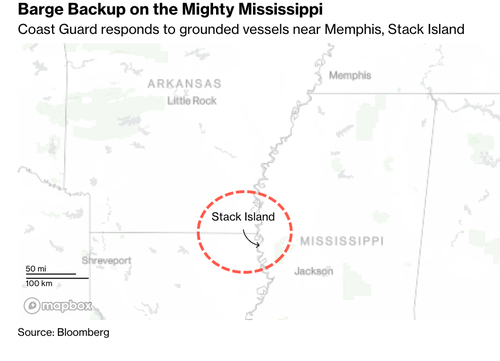Barges Grounded By “Near-Historic” Low Water Halt Mississippi River Traffic
Update (Friday):
As of Thursday afternoon, Bloomberg reported more than 117 vessels and 2,048 barges near Stack Island in Louisiana are in a logjam as a stretch of the lower Mississippi River is closed due to low water levels and vessel groundings.
“The US Army Corps of Engineers is dredging near Stack Island, and the Coast Guard intends to reopen the waterway with restrictions at some point Friday,” Bloomberg said.
* * *
The dangerously low water level in the lower Mississippi River has caused a logjam of more than 100 ships, tugboats, and barges, threatening to snarl supply chains during the harvest season in one of the US’ most crucial transport arteries, according to Bloomberg.
Lack of rainfall has water levels on the Mississippi River at “near-historic” lows and forced the largest US barge operator to declare force majeure in a letter to customers as river traffic halted.
“A prolonged lack of significant precipitation along the Mississippi River and its primary tributaries is now actively disrupting normal operations throughout the inland waterways,” Ingram Barge Company, which ferries approximately 60% of all grain exports to major terminals, said in a letter obtained by Bloomberg.
“On many river segments, Ingram has reduced its maximum allowable barge drafts and overall tow sizes in an attempt to continue to safely operate while the inland river levels fall out,” the letter continued.
The US Coast Guard has responded to an increasing number of “groundings” of barges in the past week near Stack Island in Louisiana and upriver near Memphis.
“Due to low water levels on the Lower Mississippi River, we have seen an increase in commercial vessel groundings,” said Eric Carrero, director of western rivers and waterways at Coast Guard District Eight.
Groundings have halted river traffic in both directions “to clear the grounded barges from the channel and to deepen the channel via dredging to prevent future groundings,” US Army Corps of Engineers spokesperson Sabrina Dalton told ABC News in an email.
The Coast Guard said 122 vessels were lined up in both directions near Stack Island in Louisiana and 15 in Memphis due to groundings.
The groundings and clogged waterway come at the worst possible time as corn and soybean harvests pile up at farms across the Midwest. Grains are loaded up at terminals upriver and make their way down to the Gulf of Mexico to be exported worldwide.
Lucy Fletcher of the agricultural firm AGRIServices of Brunswick, who serves on the board for the St. Louis-based trade association Inland Rivers, Ports & Terminals, told ABC that logjams on the river had sent some farmers seeking rail availability, but he said there’s limited capacity.
“Can they divert to rail?” Fletcher asked. “Well, there’s not an abundance of rail availability. And usually people are booking their transportation for fall early in the season. So if they haven’t booked that freight already, you’re going to see people in dire straits.”
And for once, Bloomberg interviewed someone who doesn’t blame man-made climate change for the deficiency of precipitation:
A peaking La Nina is limiting storms coming in from the southwest that would replenish rivers, and any significant relief is unlikely through the first 10 days of November, according to World Weather Inc. president Drew Lerner. “I don’t have a major storm coming up for the balance of the month,” Lerner said. “I’m a little pessimistic and not feeling good about the situation.”
Remember, the cause of the weather chaos across the US could be due to a weather phenomenon known as La Nina.
So river woes are expected to continue for the next couple of weeks, leading to even more groundings and logistical nightmares on the crucial waterway as farmers are in the middle of the autumn harvest.
Tyler Durden
Fri, 10/07/2022 – 06:55

